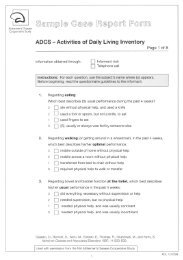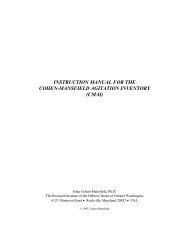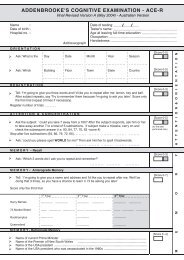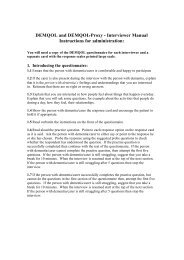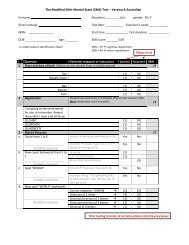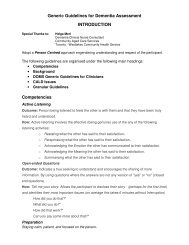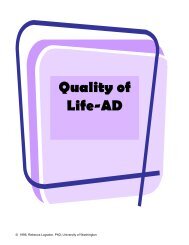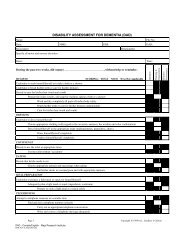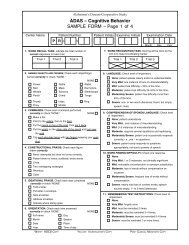Nursing Management of Disturbed Behaviour in Aged Care Facilities
Nursing Management of Disturbed Behaviour in Aged Care Facilities
Nursing Management of Disturbed Behaviour in Aged Care Facilities
You also want an ePaper? Increase the reach of your titles
YUMPU automatically turns print PDFs into web optimized ePapers that Google loves.
<strong>Nurs<strong>in</strong>g</strong> <strong>Management</strong> <strong>Aged</strong> <strong>Care</strong><br />
1. GIVE the PERSON SPACE (Stand Back) [2]. Those <strong>in</strong>volved should stop do<strong>in</strong>g whatever appears<br />
to be associated with the behaviour (e.g. chang<strong>in</strong>g a dress<strong>in</strong>g), move out <strong>of</strong> range and remove any<br />
obvious stressors (e.g. people, equipment, noise, pa<strong>in</strong> etc). However, it is particularly important to<br />
remember that if the situation is out <strong>of</strong> control and seems dangerous, then staff need to know how<br />
access the SECURITY arrangements <strong>of</strong> their particular establishment.<br />
The person may <strong>in</strong> fact be very frightened [2]. Despite any misgiv<strong>in</strong>gs you may have, you should<br />
endeavour to settle a tense situation by modell<strong>in</strong>g a CALM, FRIENDLY, EMPATHIC APPROACH,<br />
us<strong>in</strong>g the preferred name and by not argu<strong>in</strong>g or disagree<strong>in</strong>g. Endeavour to empathise (“I can see<br />
you are upset. Can I help you?”) and be particularly careful to listen to their reply and <strong>in</strong>vestigate any<br />
claims or accusations [3]. Bizarre th<strong>in</strong>gs do happen. Always consider contact<strong>in</strong>g the family and /or <strong>of</strong>fer<br />
a phone call. The ma<strong>in</strong> aim is to MEET THE IMMEDIATE NEED as appropriately as possible, as sense will<br />
not prevail until that is satisfied. Th<strong>in</strong>k creatively and laterally about how you can meet the need safely.<br />
It may be helpful to attempt to DIVERT THE ATTENTION, particularly if there could be an element<br />
<strong>of</strong> dementia <strong>in</strong>volved [4]. This might mean just walk<strong>in</strong>g away and return<strong>in</strong>g with a different, smil<strong>in</strong>g<br />
approach, or ask<strong>in</strong>g someone else to take over, or by chang<strong>in</strong>g the activity, or <strong>of</strong>fer<strong>in</strong>g food or dr<strong>in</strong>k<br />
or a walk or company etc.<br />
2. IF the PROBLEM PERSISTS it is important to seek help from senior staff and/or the medical <strong>of</strong>ficer<br />
and/or the family, quickly. If necessary, consider chemical or mechanical restra<strong>in</strong>t <strong>in</strong> the least restrictive<br />
manner possible [3]. The last resort <strong>of</strong> mechanical restra<strong>in</strong>t <strong>in</strong>creases the need for supervision plus the<br />
facility’s policy must be followed scrupulously - especially the need for a written medical order, the<br />
consent <strong>of</strong> relatives, frequent reassurance plus an observation and release time frame. The short<br />
term use <strong>of</strong> medications such as haloperidol (0.5-2mg) with small doses repeated <strong>of</strong>ten, is suggested<br />
[5,6,7,8]. <strong>Care</strong>ful monitor<strong>in</strong>g for signs <strong>of</strong> effectiveness or the development <strong>of</strong> Park<strong>in</strong>sonian or<br />
extrapyramidal features is essential (e.g. facial spasms, restlessness, tremor, rigidity, stooped posture etc).<br />
3. Don’t hesitate to call for help from the facility’s designated SECURITY staff if any real danger<br />
persists. A policy and protocol should be <strong>in</strong> place to support staff actions.<br />
4. Afterwards it is important to EVALUATE the event. Review and discussion is important to ensure<br />
that this <strong>in</strong>cident does not happen aga<strong>in</strong>. Documentation by way <strong>of</strong> a <strong>Behaviour</strong> Chart can be helpful<br />
<strong>in</strong> mapp<strong>in</strong>g and understand<strong>in</strong>g events [2]. This should <strong>in</strong>clude: A - the ANTECEDENT - exactly what<br />
happened before the event; B - the BEHAVIOUR - exactly what behaviour occurred; C - the CONSEQUENCES<br />
- what response was there from others? (See Appendix A).<br />
The A or Antecedent is most important and is a description <strong>of</strong> the events immediately preced<strong>in</strong>g the<br />
aggressive event, such as, ‘I shook Mr X on the arm to wake him up’ or ‘Mrs Y sat down on Mrs Z’s bed’.<br />
Look for the trigger or ‘activat<strong>in</strong>g event’ as well as patterns <strong>of</strong> activity that result from the behaviour,<br />
which could be implicated <strong>in</strong> the whole event.<br />
5. Always remember to SUPPORT the STAFF MEMBER and OTHER PEOPLE INVOLVED and arrange<br />
a time to allow them to recount their part <strong>in</strong> the <strong>in</strong>cident and ventilate their subsequent feel<strong>in</strong>gs.<br />
Incidents <strong>in</strong>volv<strong>in</strong>g aggression are frighten<strong>in</strong>g for all <strong>in</strong>volved. Staff motivation is positively enhanced<br />
when emotional needs are recognised and supported [9].<br />
6. With the ‘ABC’ <strong>in</strong> m<strong>in</strong>d, PLAN the ongo<strong>in</strong>g MANAGEMENT. Always aim for a consistent approach<br />
with consideration <strong>of</strong> the possibility <strong>of</strong> personal misunderstand<strong>in</strong>gs, varied communication skills and<br />
prejudices both <strong>in</strong> the patient and the staff. Inform the medical <strong>of</strong>ficer and facilitate assessment for<br />
delirium and/or depression or other mental disorders. At all times DOCUMENT the events clearly,<br />
particularly <strong>in</strong> the management plan and <strong>in</strong> the ongo<strong>in</strong>g CARE PLAN.<br />
Could there be medical problems?<br />
If ‘yes’ go to next section page 6, if ‘NO’ go to page 12.



